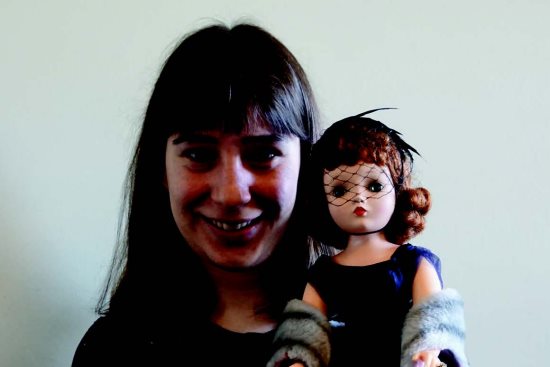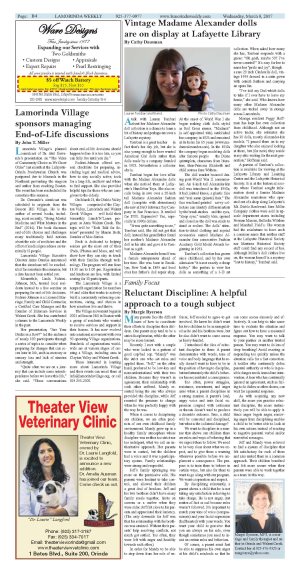| | Published March 8th, 2017
| Vintage Madame Alexander dolls are on display at Lafayette Library
| | | By Cathy Dausman |  | | Lauren Tombari and friend. Photo Cathy Dausman |
A talk with Lauren Tombari about her Madame Alexander doll collection is a chance to learn a bit of history and perhaps uncover a Lafayette mystery.
 Tombari is a great teacher - in fact that's her day job, but she is also young enough to have wanted American Girl dolls rather than dolls made by a company founded in 1923. Nevertheless a collector she is.
Tombari is a great teacher - in fact that's her day job, but she is also young enough to have wanted American Girl dolls rather than dolls made by a company founded in 1923. Nevertheless a collector she is.
 Tombari began her love affair with the Madam Alexander dolls when she noticed them at Lafayette's Handlebar Toys. She also recalls being in awe over a 20-inch tall Madame Alexander fashion doll (complete with rhinestones) she saw at FAO Schwarz Toy Company in San Francisco. It retailed for $700. Expensive? Yes, especially in 1990s dollars.
Tombari began her love affair with the Madam Alexander dolls when she noticed them at Lafayette's Handlebar Toys. She also recalls being in awe over a 20-inch tall Madame Alexander fashion doll (complete with rhinestones) she saw at FAO Schwarz Toy Company in San Francisco. It retailed for $700. Expensive? Yes, especially in 1990s dollars.
 "It was quite something to see," Tombari said. She did not get that doll; instead her grandfather found her mother's Madame Alexander doll in his attic and gave it to Tombari as a gift.
"It was quite something to see," Tombari said. She did not get that doll; instead her grandfather found her mother's Madame Alexander doll in his attic and gave it to Tombari as a gift.
 Madame Alexander herself was a female entrepreneur ahead of her time. She was born in Brooklyn, New York in 1895 and lived over her father's doll repair shop. At the onset of World War I she began making cloth dolls styled as Red Cross nurses. "Madame" (a self-appointed title) established her company in 1923 and remained at its helm for 65 years (www.madamealexander.com). In the 1930s the company began modeling dolls after famous people - the Dione quintuplets, characters from literature, then-Princess Elizabeth and child actress Jane Withers.
Madame Alexander herself was a female entrepreneur ahead of her time. She was born in Brooklyn, New York in 1895 and lived over her father's doll repair shop. At the onset of World War I she began making cloth dolls styled as Red Cross nurses. "Madame" (a self-appointed title) established her company in 1923 and remained at its helm for 65 years (www.madamealexander.com). In the 1930s the company began modeling dolls after famous people - the Dione quintuplets, characters from literature, then-Princess Elizabeth and child actress Jane Withers.
 The doll market boomed during post-World War II consumerism. An 8-inch tall Alexander-kin doll was introduced in the 1950s; it had jointed knees, a plastic face and "real saran (plastic) hair." The face was hand painted - savvy collectors can identify different artists by the brush strokes - and the eyes, "sleep eyes," usually blue, opened and closed as the doll was made to stand or recline. The dolls' attention-to-detail clothing and myriad accessories earned Madame Alexander four consecutive Fashion Academy Gold Medal Awards beginning in 1951.
The doll market boomed during post-World War II consumerism. An 8-inch tall Alexander-kin doll was introduced in the 1950s; it had jointed knees, a plastic face and "real saran (plastic) hair." The face was hand painted - savvy collectors can identify different artists by the brush strokes - and the eyes, "sleep eyes," usually blue, opened and closed as the doll was made to stand or recline. The dolls' attention-to-detail clothing and myriad accessories earned Madame Alexander four consecutive Fashion Academy Gold Medal Awards beginning in 1951.
 Tombari's collection has grown since childhood, and by her own admission "it is not exactly a cheap hobby." She prefers to view her dolls as something of a 3-D art collection. When asked how many she has, Tombari responds with a guess: "Oh gosh, maybe 50? I've never counted!" It's easy for her to name her "pride and joy", though - a rare 20 inch Cinderella doll, vintage 1955 dressed in a satin gown with ostrich feathers and carrying an opera fan.
Tombari's collection has grown since childhood, and by her own admission "it is not exactly a cheap hobby." She prefers to view her dolls as something of a 3-D art collection. When asked how many she has, Tombari responds with a guess: "Oh gosh, maybe 50? I've never counted!" It's easy for her to name her "pride and joy", though - a rare 20 inch Cinderella doll, vintage 1955 dressed in a satin gown with ostrich feathers and carrying an opera fan.
 "I've told my Dad which dolls to take if I ever have to leave my house," she said. Who knows how many other Madame Alexander dolls are tucked away in storage across Lamorinda.
"I've told my Dad which dolls to take if I ever have to leave my house," she said. Who knows how many other Madame Alexander dolls are tucked away in storage across Lamorinda.
 Moraga resident Peggy Hoffman has kept her own collection from childhood. Although not an active trader, she estimates she has 30 dolls, mostly Alexander-kin models. "I passed them on to my daughter who also enjoyed looking at them, but (for now) they reside in my attic waiting for the next generation," Hoffman said.
Moraga resident Peggy Hoffman has kept her own collection from childhood. Although not an active trader, she estimates she has 30 dolls, mostly Alexander-kin models. "I passed them on to my daughter who also enjoyed looking at them, but (for now) they reside in my attic waiting for the next generation," Hoffman said.
 A portion of Tombari's collection is available for viewing at the Lafayette Library and Learning Center and the Lafayette Historical Society. It is at the historical society where Tombari sought information about a former Madame Alexander seamstress who operated out of a shop along Lafayette's Mt. Diablo Boulevard. Jane Miller Company clothes were sold in upscale department stores including Neiman Marcus, Bullocks Wilshire and Marshall Field's. The woman had the misfortune to have such a common name that neither staff at the Lafayette Historical Society nor Martinez Historical Society staff could find any record of her. Although Miller's doll clothes live on, the woman herself is a mystery "lost to history," Tombari said.
A portion of Tombari's collection is available for viewing at the Lafayette Library and Learning Center and the Lafayette Historical Society. It is at the historical society where Tombari sought information about a former Madame Alexander seamstress who operated out of a shop along Lafayette's Mt. Diablo Boulevard. Jane Miller Company clothes were sold in upscale department stores including Neiman Marcus, Bullocks Wilshire and Marshall Field's. The woman had the misfortune to have such a common name that neither staff at the Lafayette Historical Society nor Martinez Historical Society staff could find any record of her. Although Miller's doll clothes live on, the woman herself is a mystery "lost to history," Tombari said.


|
| | | | | | | | | | | | |



